Abstract
We update our 1997 publication by reviewing 29 new reports of tests of magnetic fields (MFs) in six different in vivo animal models of carcinogenesis: 2-year, lifetime, or multigeneration exposure studies in rats or mice; and promotion/progression models (rat mammary carcinoma, rat liver focus, mouse skin, several models of human leukemia/lymphoma in rats and mice, and brain cancer in rats). Individual experiments are evaluated using a set of data quality criteria, and summary judgments are made across multiple experiments by applying a criterion of rough reproducibility. The potential for carcinogenicity of MFs is discussed in light of the significant body of carcinogenesis data from animal bioassays that now exists. Excluding abstracts, approximately 80% of the 41 completed studies identified in this and our previous review roughly satisfy data quality criteria. Among these studies, the criterion for independent reproducibility is not satisfied for any positive results but is satisfied for negative results in chronic bioassays in rats and mice and for negative results in both promotion and co-promotion assays using the SENCAR mouse skin model. Results of independent replication studies using the rat mammary carcinoma model were conflicting. We conclude that long-term exposure to continuous 50- or 60-Hz MFs in the range of 0.002-5 mT is unlikely to result in carcinogenesis in rats or mice. Though results of most promotion/progression assays are negative, a weak promoting effect of MFs under certain exposure conditions cannot be ruled out based on available data.
Full text
PDF
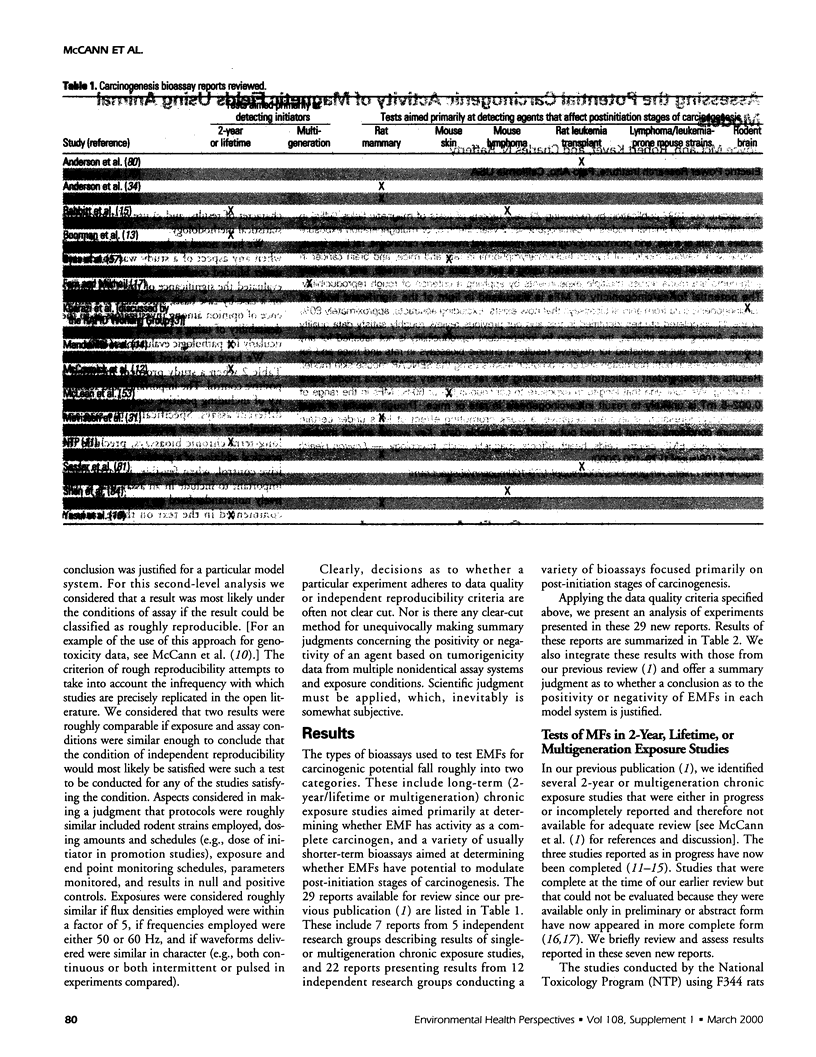
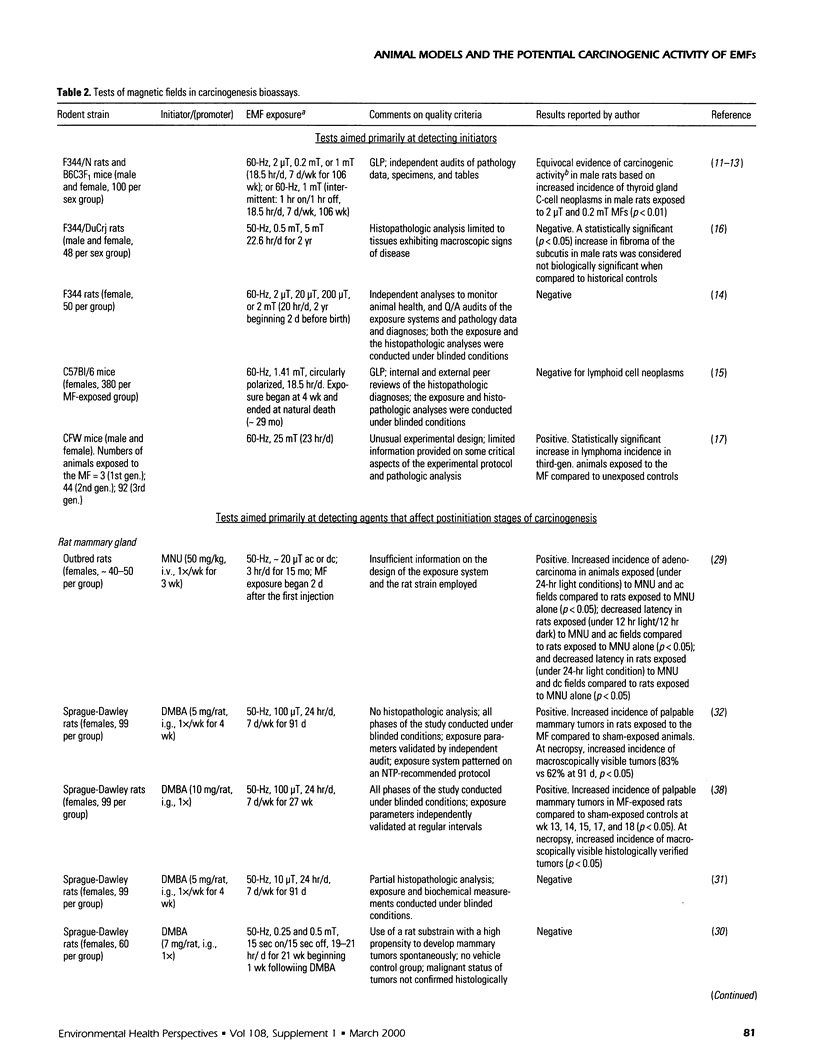
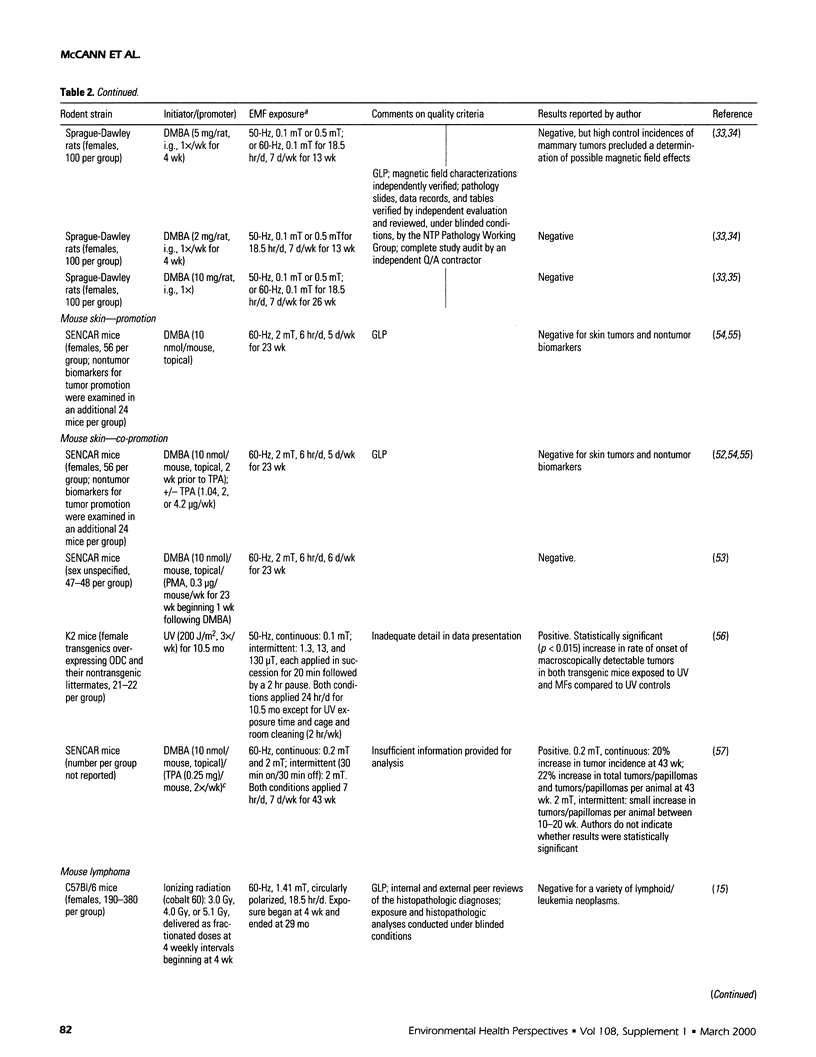
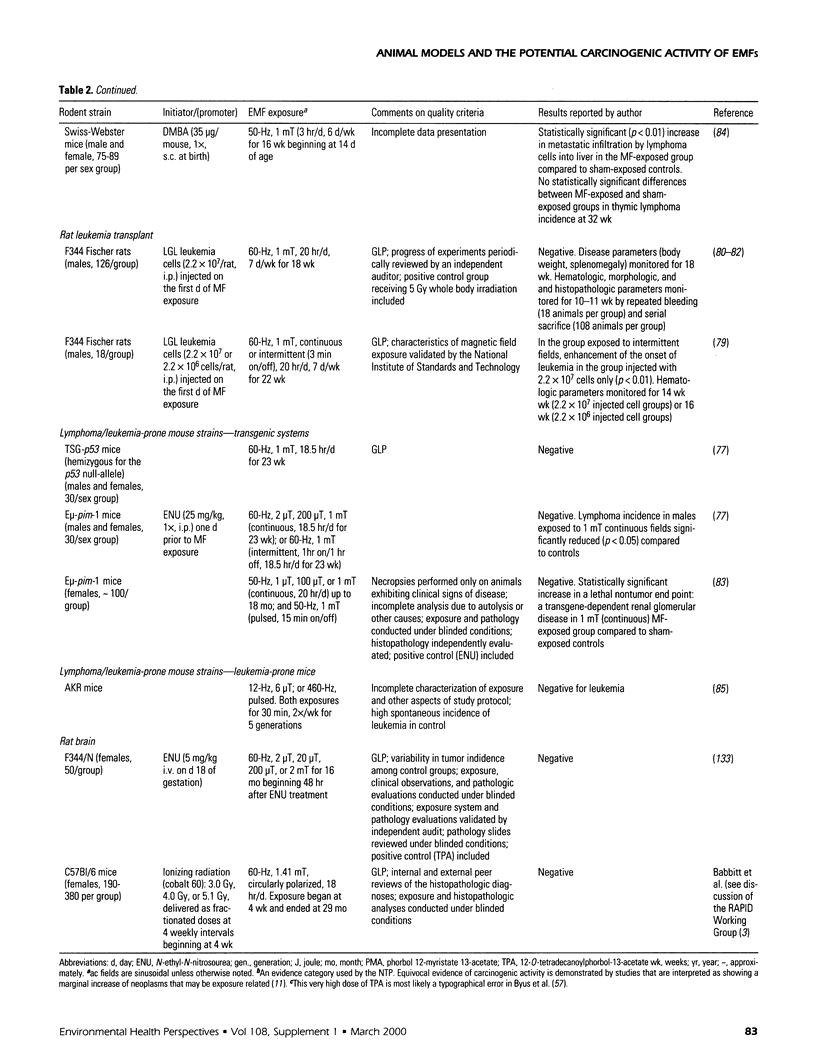
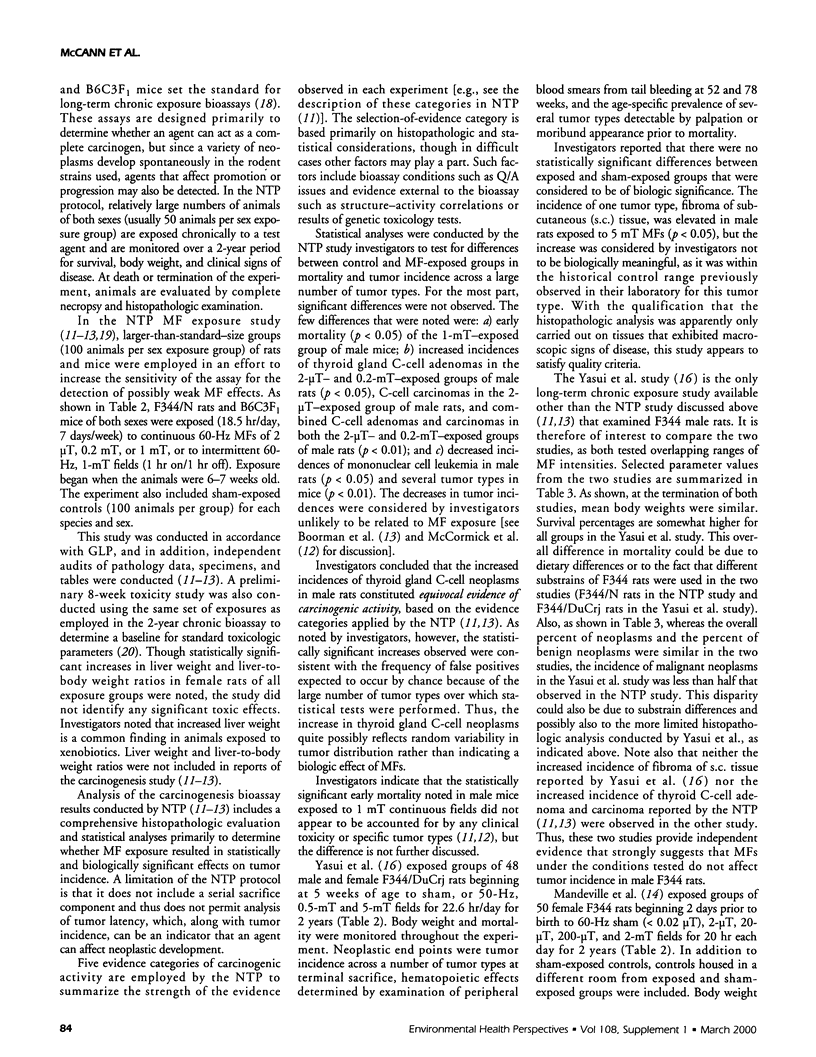

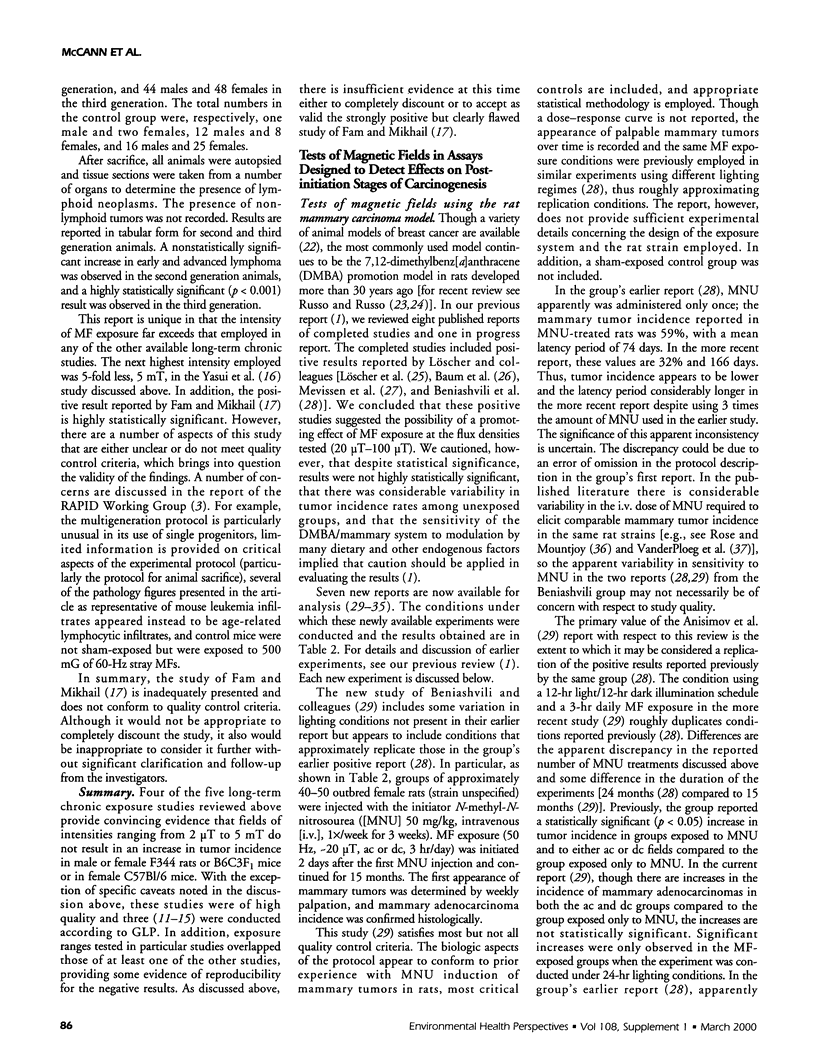
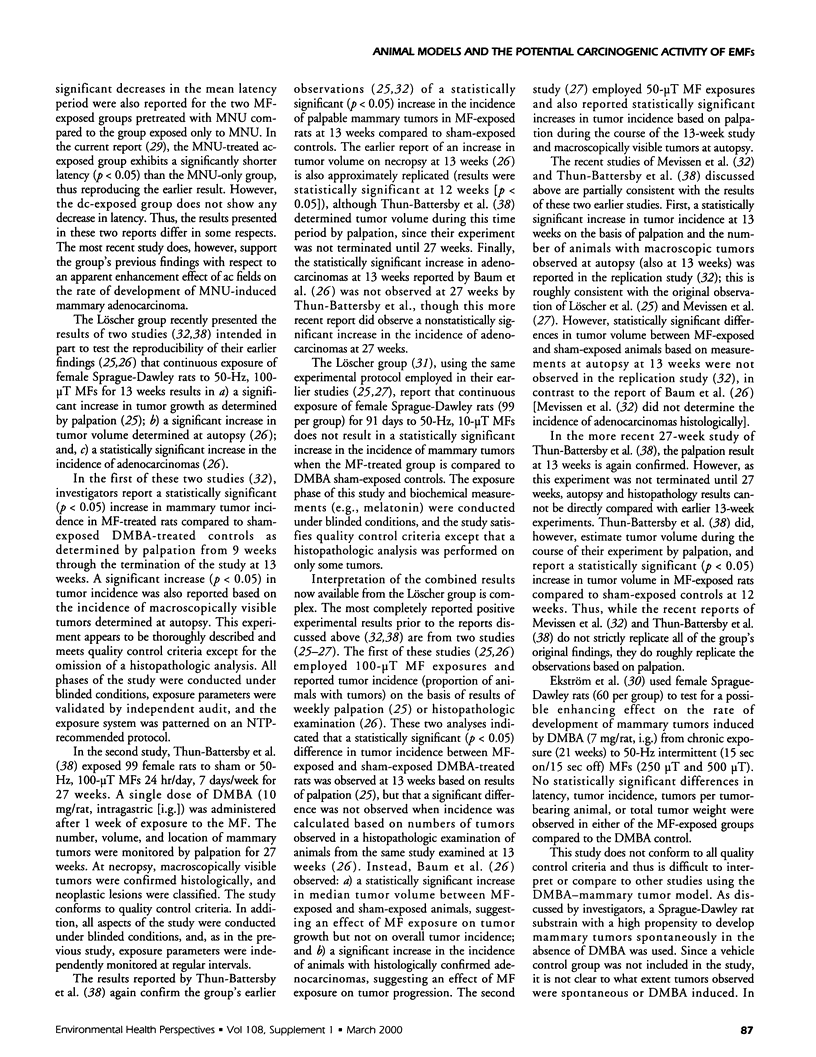
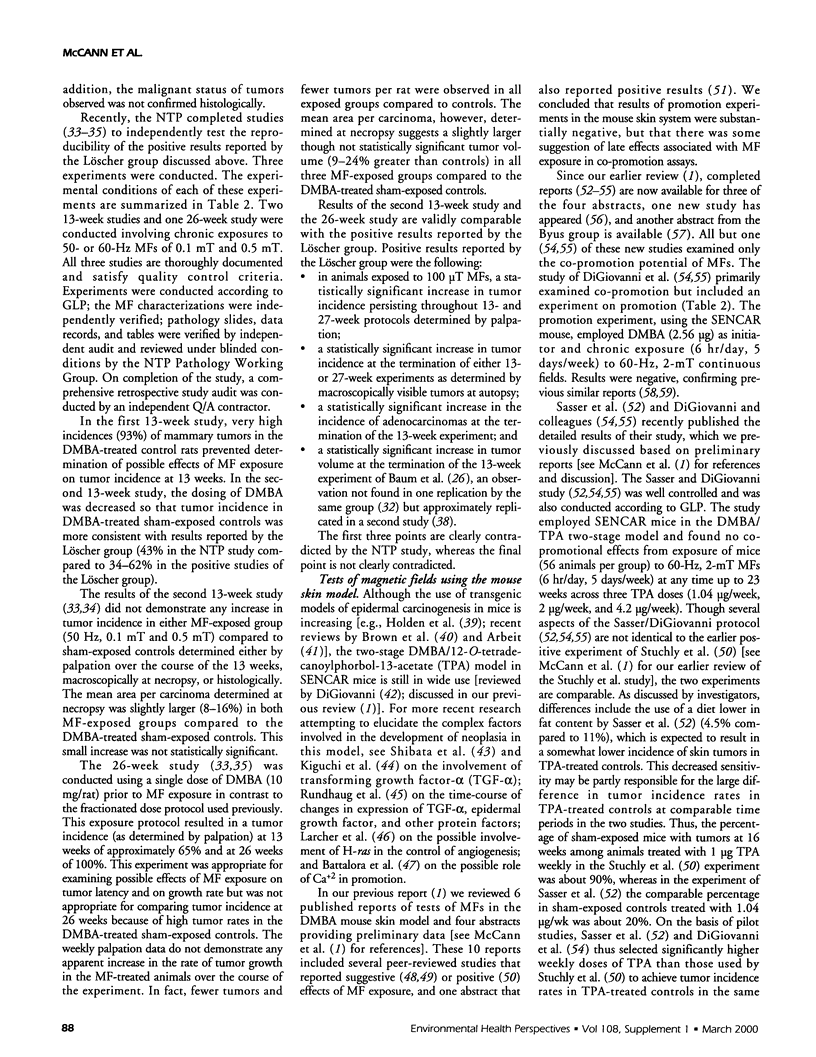
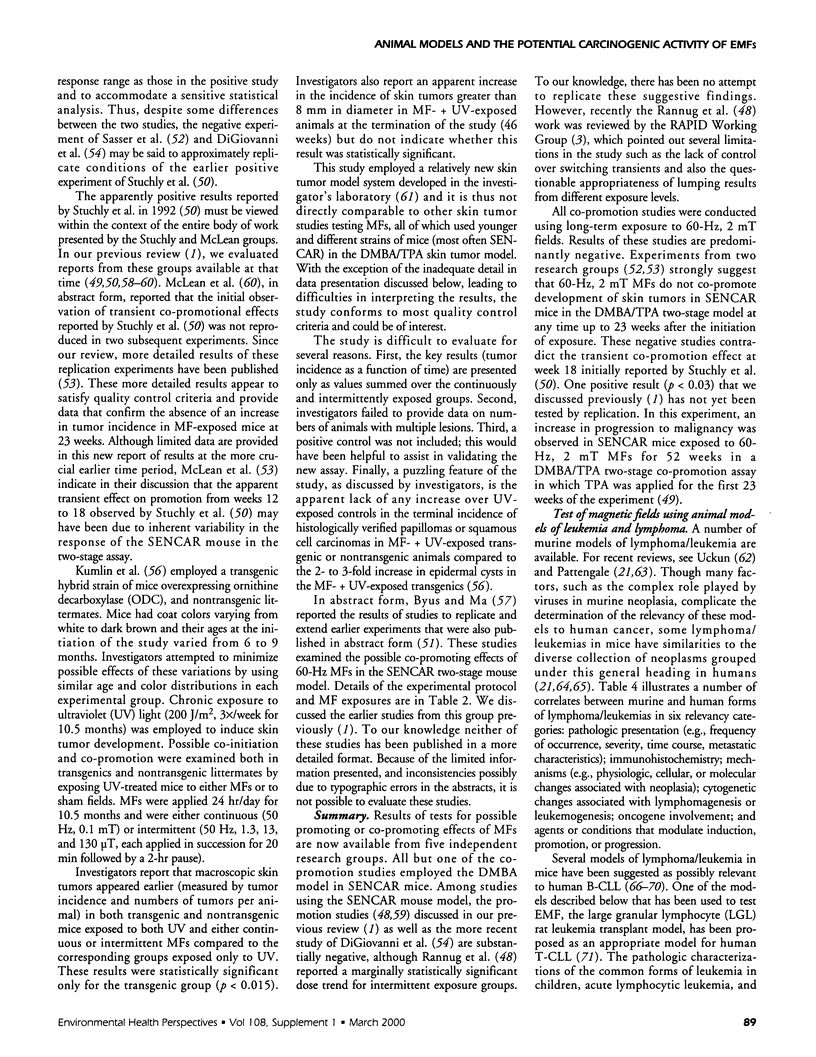
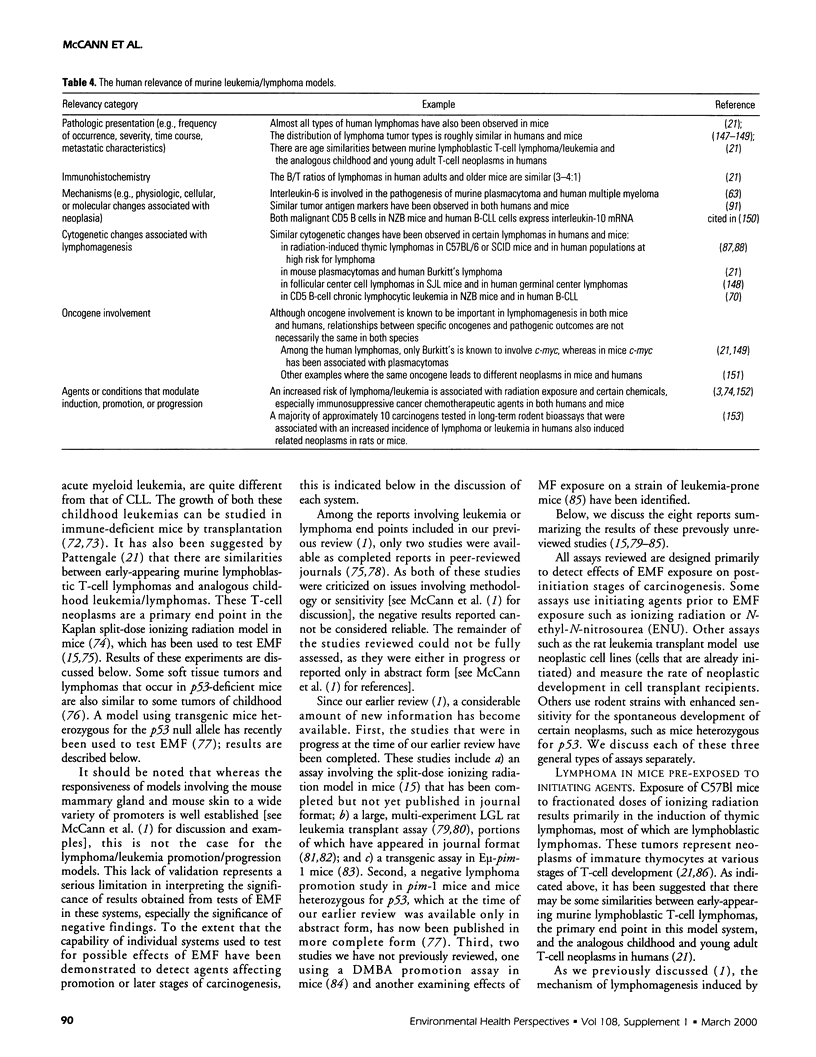
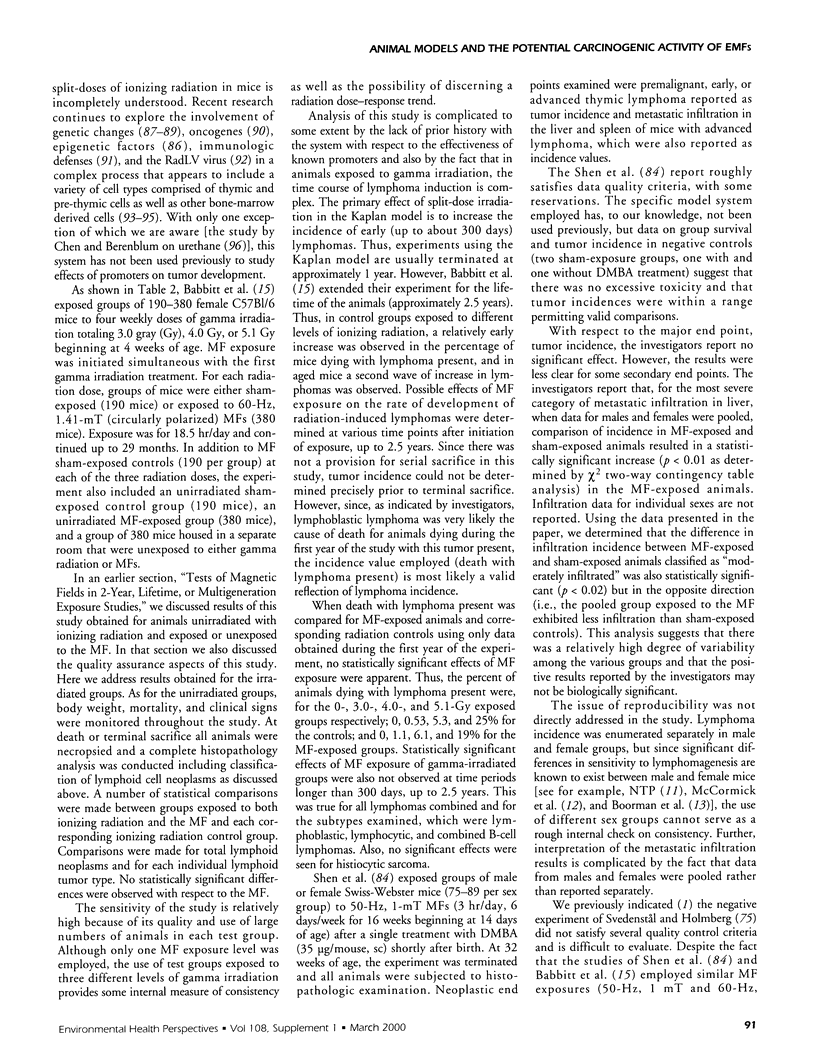
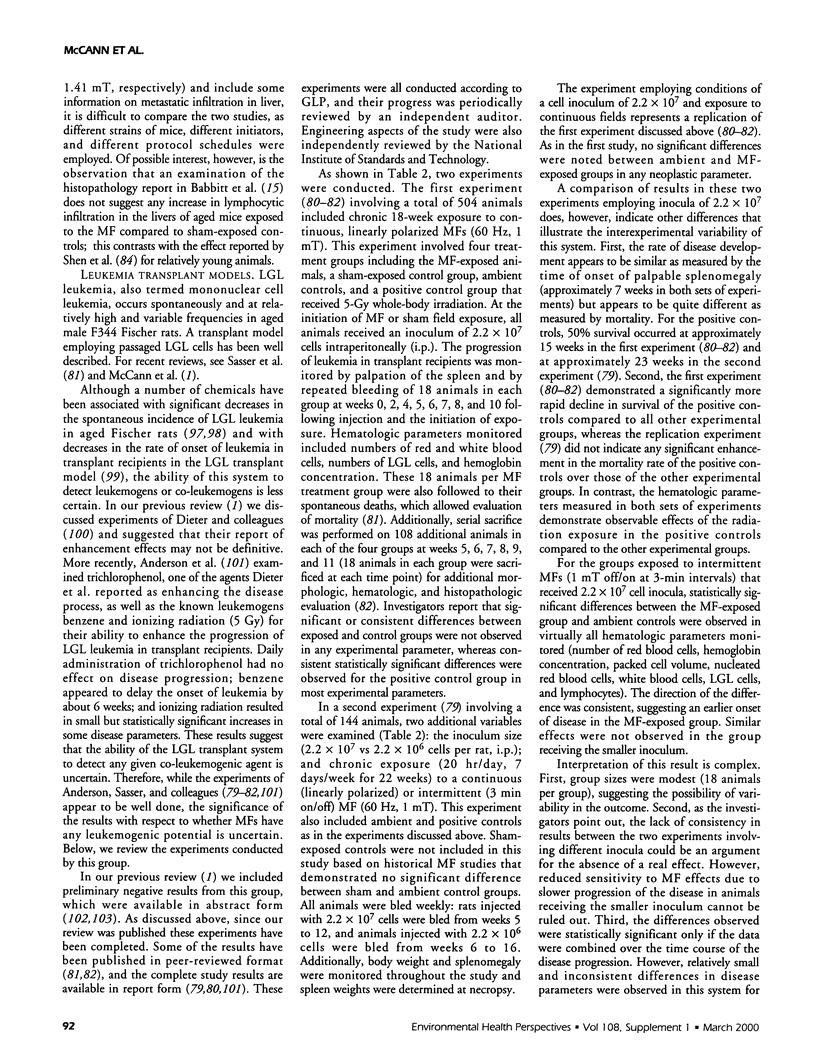
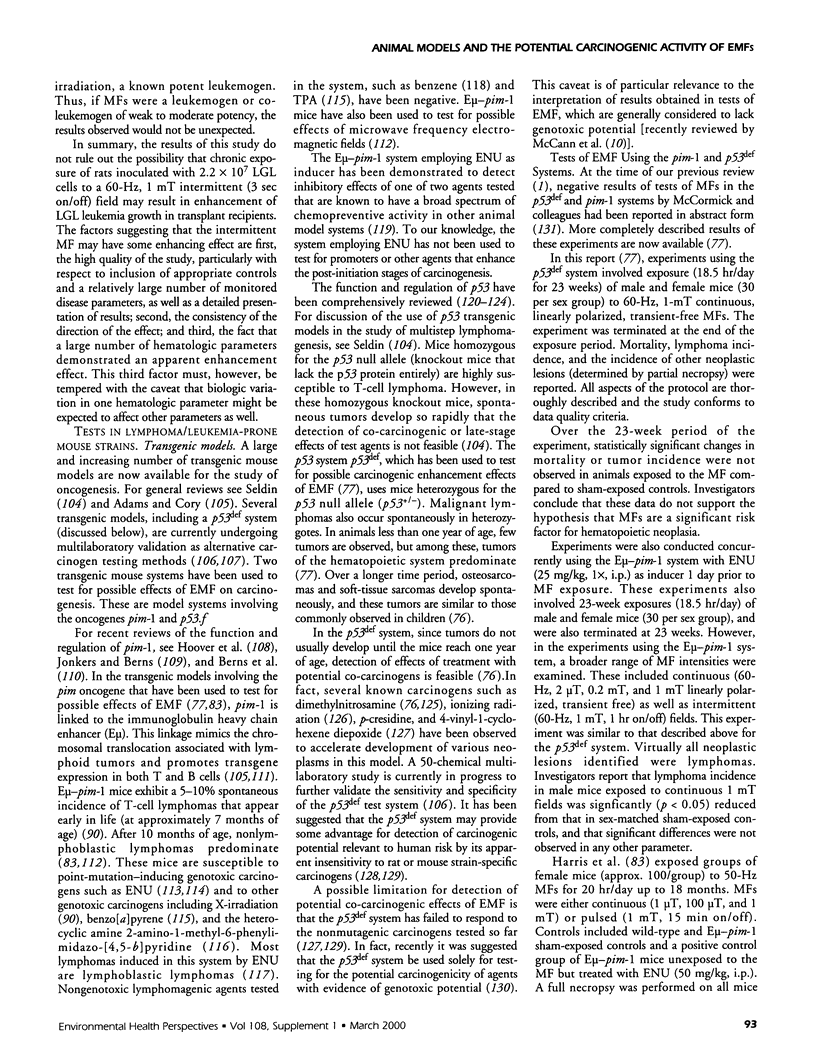
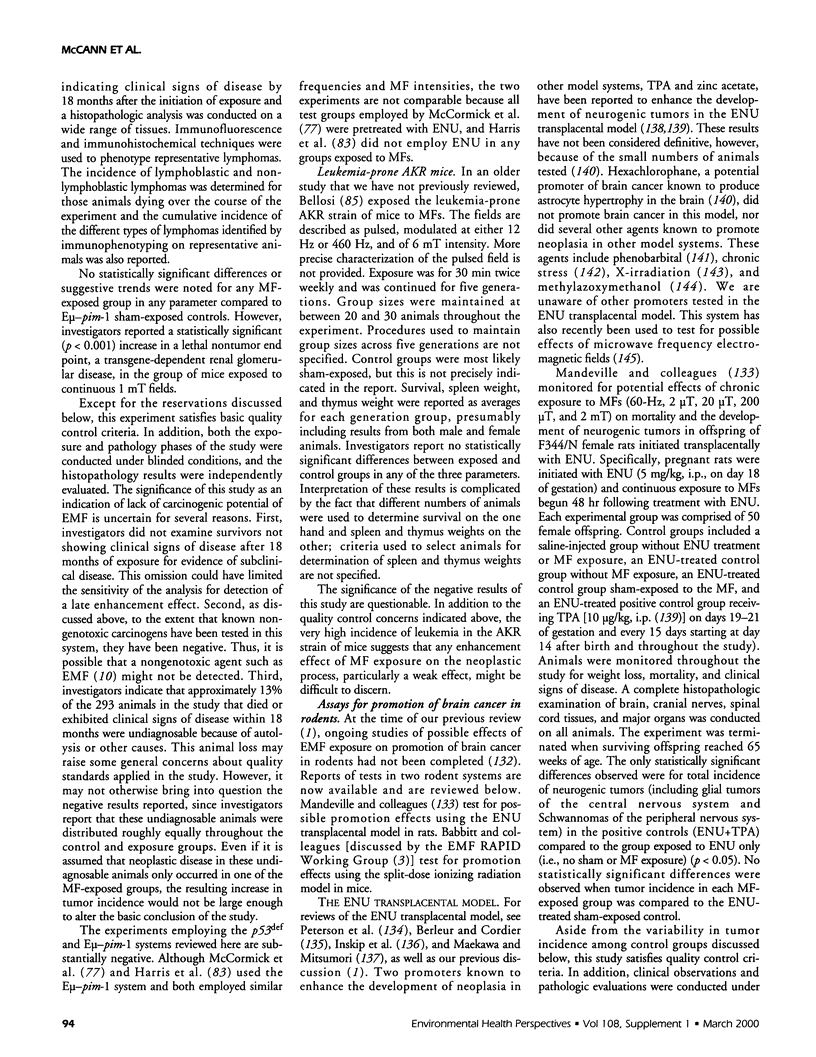
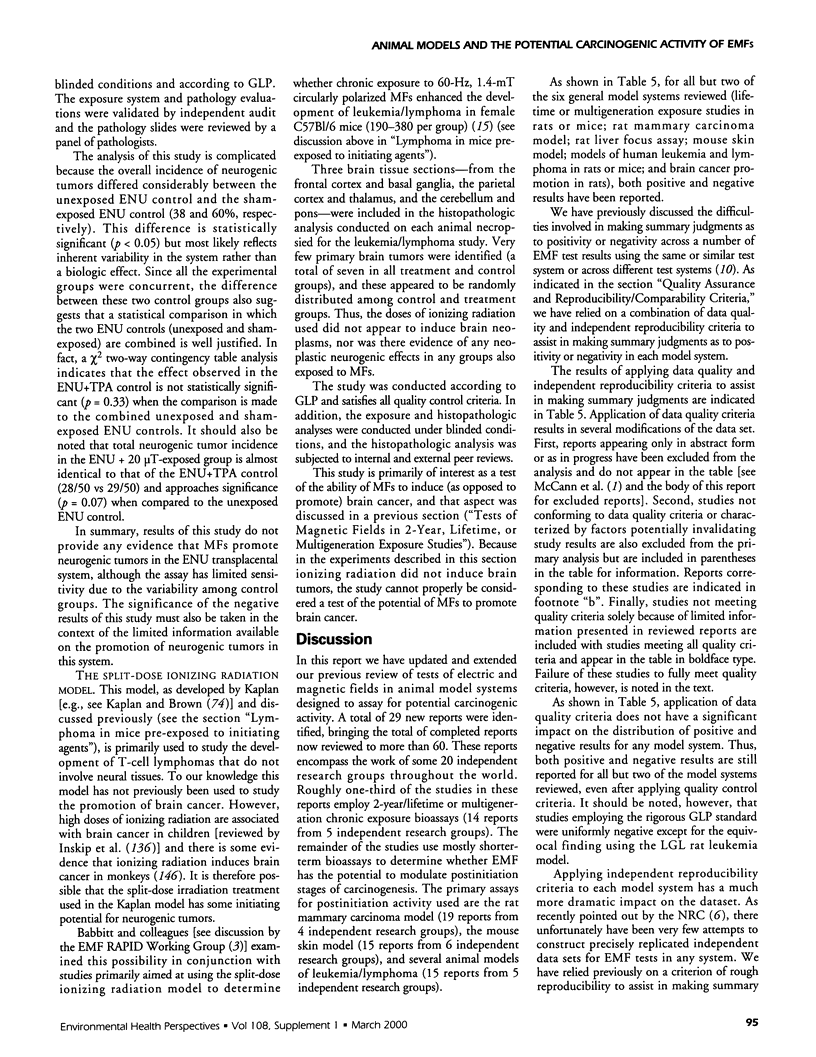
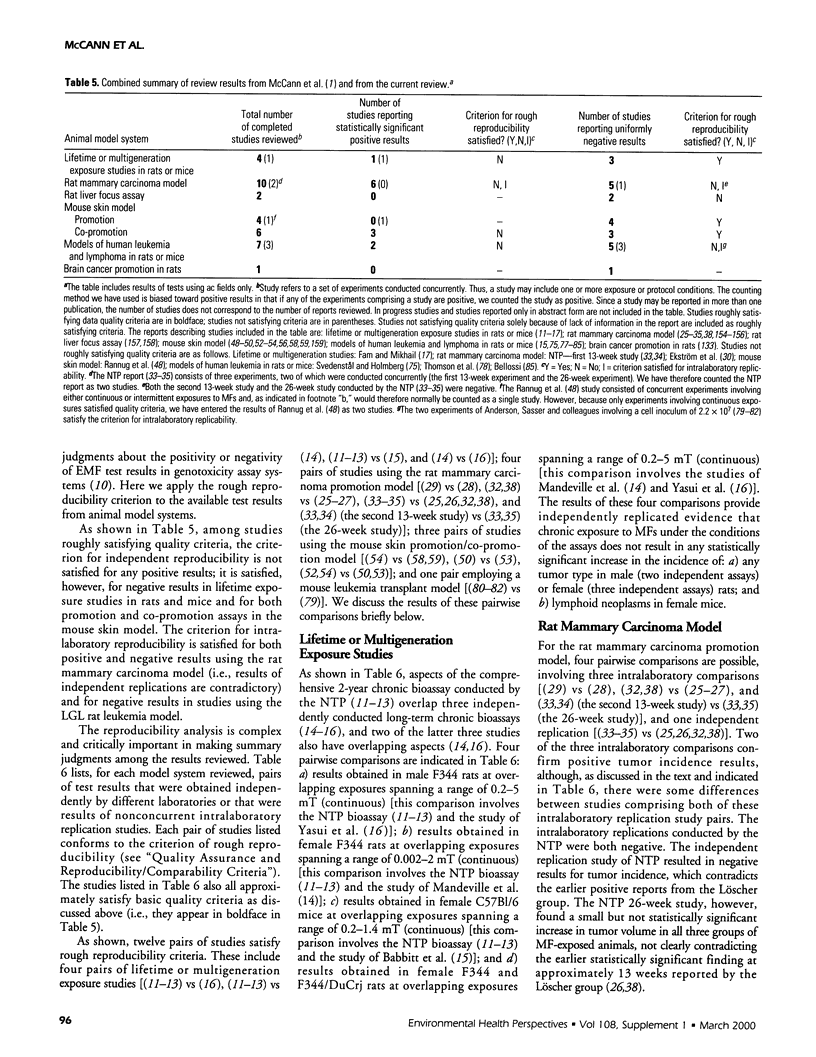
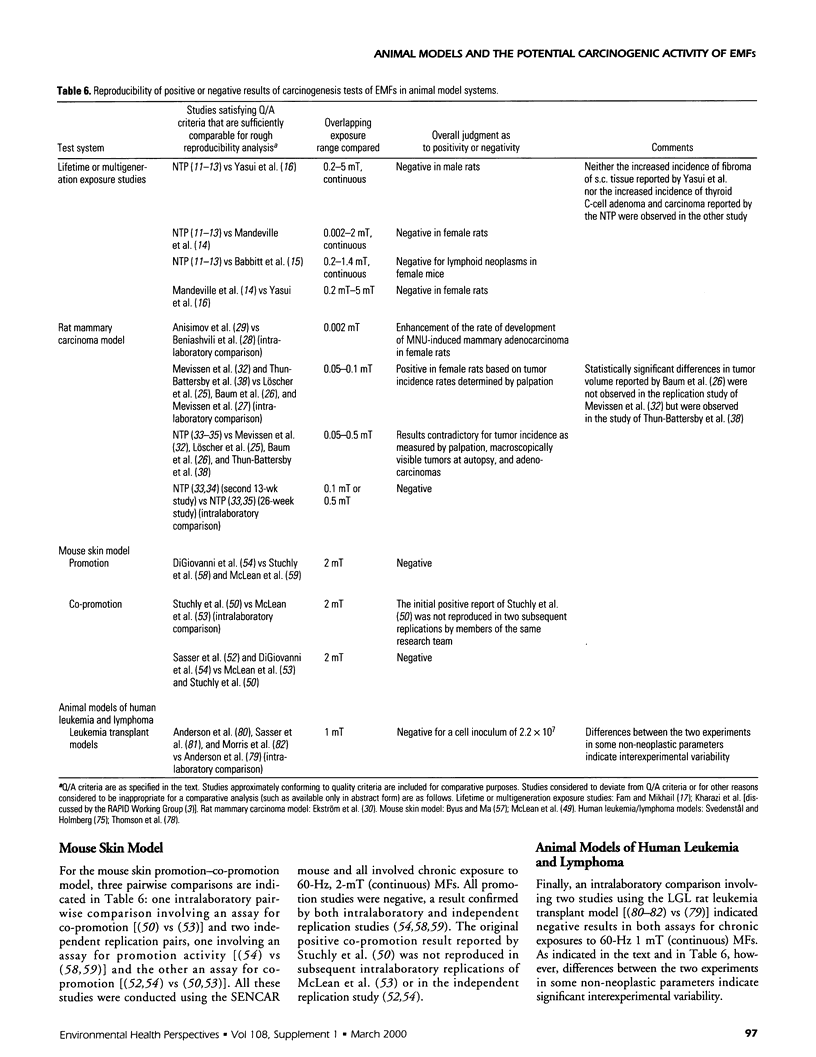
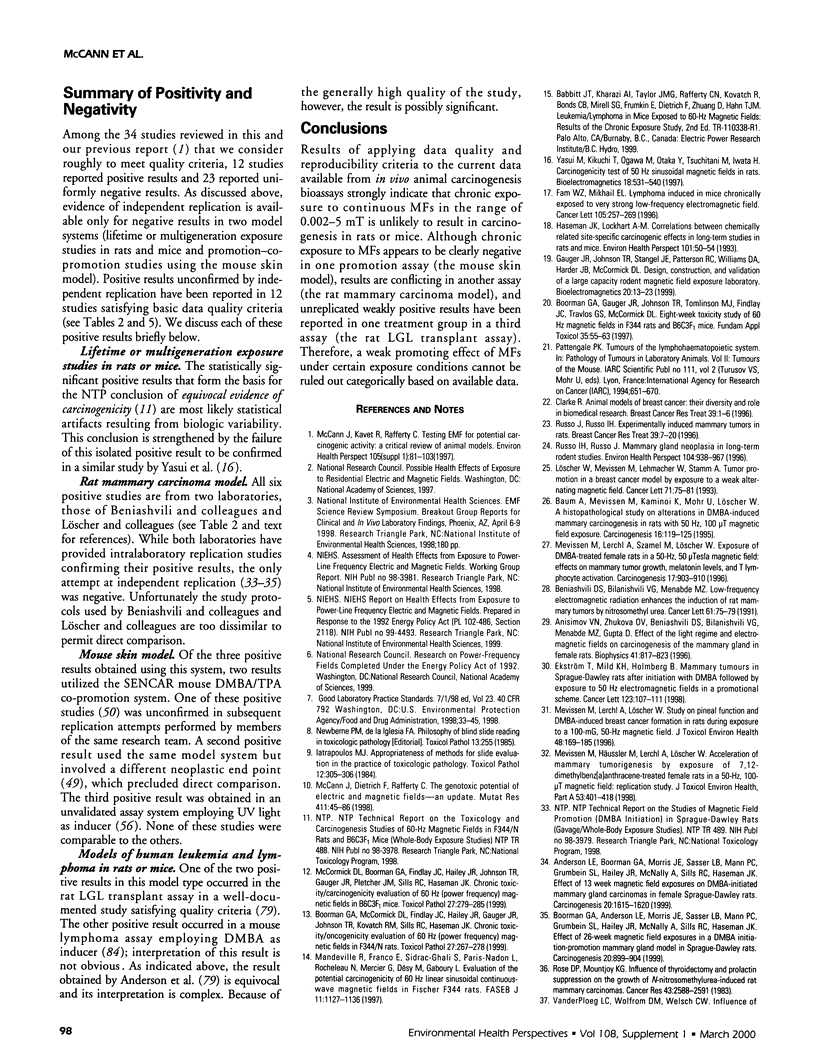
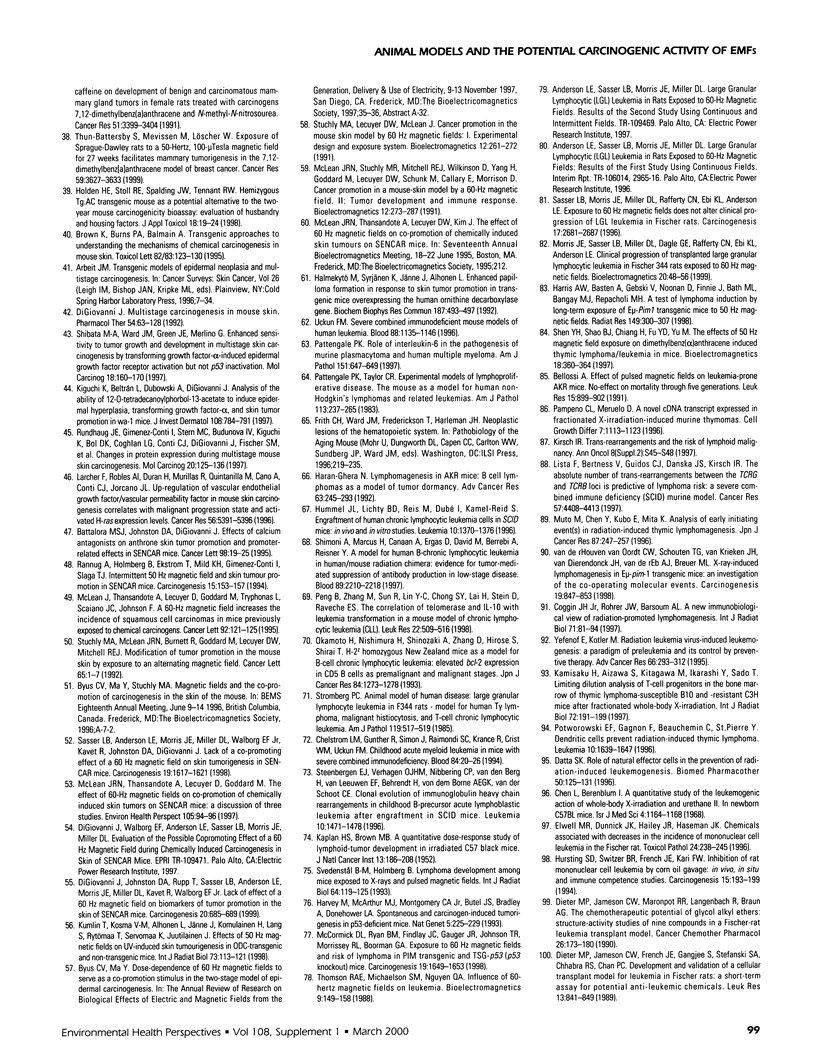
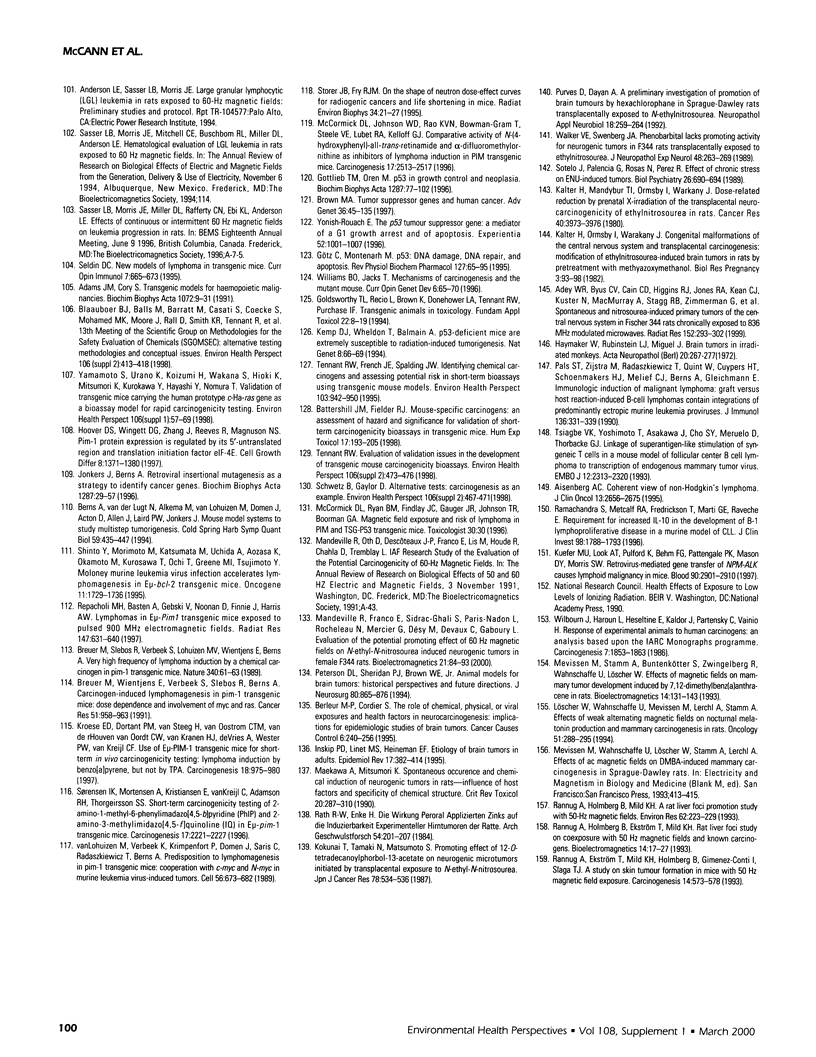
Selected References
These references are in PubMed. This may not be the complete list of references from this article.
- Adams J. M., Cory S. Transgenic models for haemopoietic malignancies. Biochim Biophys Acta. 1991 Apr 16;1072(1):9–31. doi: 10.1016/0304-419x(91)90004-5. [DOI] [PubMed] [Google Scholar]
- Adey W. R., Byus C. V., Cain C. D., Higgins R. J., Jones R. A., Kean C. J., Kuster N., MacMurray A., Stagg R. B., Zimmerman G. Spontaneous and nitrosourea-induced primary tumors of the central nervous system in Fischer 344 rats chronically exposed to 836 MHz modulated microwaves. Radiat Res. 1999 Sep;152(3):293–302. [PubMed] [Google Scholar]
- Aisenberg A. C. Coherent view of non-Hodgkin's lymphoma. J Clin Oncol. 1995 Oct;13(10):2656–2675. doi: 10.1200/JCO.1995.13.10.2656. [DOI] [PubMed] [Google Scholar]
- Anderson L. E., Boorman G. A., Morris J. E., Sasser L. B., Mann P. C., Grumbein S. L., Hailey J. R., McNally A., Sills R. C., Haseman J. K. Effect of 13 week magnetic field exposures on DMBA-initiated mammary gland carcinomas in female Sprague-Dawley rats. Carcinogenesis. 1999 Aug;20(8):1615–1620. doi: 10.1093/carcin/20.8.1615. [DOI] [PMC free article] [PubMed] [Google Scholar]
- Arbeit J. M. Transgenic models of epidermal neoplasia and multistage carcinogenesis. Cancer Surv. 1996;26:7–34. [PubMed] [Google Scholar]
- Battalora M. S., Johnston D. A., DiGiovanni J. The effects of calcium antagonists on anthrone skin tumor promotion and promoter-related effects in SENCAR mice. Cancer Lett. 1995 Nov 27;98(1):19–25. [PubMed] [Google Scholar]
- Battershill J. M., Fielder R. J. Mouse-specific carcinogens: an assessment of hazard and significance for validation of short-term carcinogenicity bioassays in transgenic mice. Hum Exp Toxicol. 1998 Apr;17(4):193–205. doi: 10.1177/096032719801700401. [DOI] [PubMed] [Google Scholar]
- Baum A., Mevissen M., Kamino K., Mohr U., Löscher W. A histopathological study on alterations in DMBA-induced mammary carcinogenesis in rats with 50 Hz, 100 muT magnetic field exposure. Carcinogenesis. 1995 Jan;16(1):119–125. doi: 10.1093/carcin/16.1.119. [DOI] [PubMed] [Google Scholar]
- Bellossi A. Effect of pulsed magnetic fields on leukemia-prone AKR mice. No-effect on mortality through five generations. Leuk Res. 1991;15(10):899–902. doi: 10.1016/0145-2126(91)90165-p. [DOI] [PubMed] [Google Scholar]
- Beniashvili D. S., Bilanishvili V. G., Menabde M. Z. Low-frequency electromagnetic radiation enhances the induction of rat mammary tumors by nitrosomethyl urea. Cancer Lett. 1991 Dec 9;61(1):75–79. doi: 10.1016/0304-3835(91)90079-w. [DOI] [PubMed] [Google Scholar]
- Berleur M. P., Cordier S. The role of chemical, physical, or viral exposures and health factors in neurocarcinogenesis: implications for epidemiologic studies of brain tumors. Cancer Causes Control. 1995 May;6(3):240–256. doi: 10.1007/BF00051796. [DOI] [PubMed] [Google Scholar]
- Berns A., van der Lugt N., Alkema M., van Lohuizen M., Domen J., Acton D., Allen J., Laird P. W., Jonkers J. Mouse model systems to study multistep tumorigenesis. Cold Spring Harb Symp Quant Biol. 1994;59:435–447. doi: 10.1101/sqb.1994.059.01.049. [DOI] [PubMed] [Google Scholar]
- Blaauboer B. J., Balls M., Barratt M., Casati S., Coecke S., Mohamed M. K., Moore J., Rall D., Smith K. R., Tennant R. 13th meeting of the Scientific Group on Methodologies for the Safety Evaluation of Chemicals (SGOMSEC): alternative testing methodologies and conceptual issues. Environ Health Perspect. 1998 Apr;106 (Suppl 2):413–418. doi: 10.1289/ehp.98106413. [DOI] [PMC free article] [PubMed] [Google Scholar]
- Boorman G. A., Anderson L. E., Morris J. E., Sasser L. B., Mann P. C., Grumbein S. L., Hailey J. R., McNally A., Sills R. C., Haseman J. K. Effect of 26 week magnetic field exposures in a DMBA initiation-promotion mammary gland model in Sprague-Dawley rats. Carcinogenesis. 1999 May;20(5):899–904. doi: 10.1093/carcin/20.5.899. [DOI] [PMC free article] [PubMed] [Google Scholar]
- Boorman G. A., Gauger J. R., Johnson T. R., Tomlinson M. J., Findlay J. C., Travlos G. S., McCormick D. L. Eight-week toxicity study of 60 Hz magnetic fields in F344 rats and B6C3F1 mice. Fundam Appl Toxicol. 1997 Jan;35(1):55–63. doi: 10.1006/faat.1996.2257. [DOI] [PubMed] [Google Scholar]
- Boorman G. A., McCormick D. L., Findlay J. C., Hailey J. R., Gauger J. R., Johnson T. R., Kovatch R. M., Sills R. C., Haseman J. K. Chronic toxicity/oncogenicity evaluation of 60 Hz (power frequency) magnetic fields in F344/N rats. Toxicol Pathol. 1999 May-Jun;27(3):267–278. doi: 10.1177/019262339902700301. [DOI] [PubMed] [Google Scholar]
- Breuer M., Slebos R., Verbeek S., van Lohuizen M., Wientjens E., Berns A. Very high frequency of lymphoma induction by a chemical carcinogen in pim-1 transgenic mice. Nature. 1989 Jul 6;340(6228):61–63. doi: 10.1038/340061a0. [DOI] [PubMed] [Google Scholar]
- Breuer M., Wientjens E., Verbeek S., Slebos R., Berns A. Carcinogen-induced lymphomagenesis in pim-1 transgenic mice: dose dependence and involvement of myc and ras. Cancer Res. 1991 Feb 1;51(3):958–963. [PubMed] [Google Scholar]
- Brown K., Burns P. A., Balmain A. Transgenic approaches to understanding the mechanisms of chemical carcinogenesis in mouse skin. Toxicol Lett. 1995 Dec;82-83:123–130. doi: 10.1016/0378-4274(95)03549-4. [DOI] [PubMed] [Google Scholar]
- Brown M. A. Tumor suppressor genes and human cancer. Adv Genet. 1997;36:45–135. doi: 10.1016/s0065-2660(08)60307-7. [DOI] [PubMed] [Google Scholar]
- Chelstrom L. M., Gunther R., Simon J., Raimondi S. C., Krance R., Crist W. M., Uckun F. M. Childhood acute myeloid leukemia in mice with severe combined immunodeficiency. Blood. 1994 Jul 1;84(1):20–26. [PubMed] [Google Scholar]
- Chen L., Berenblum I. A quantitative study of the leukemogenic action of whole-body x-irradiation and urethane. II. In newborn C57BL mice. Isr J Med Sci. 1968 Nov-Dec;4(6):1164–1168. [PubMed] [Google Scholar]
- Clarke R. Animal models of breast cancer: their diversity and role in biomedical research. Breast Cancer Res Treat. 1996;39(1):1–6. doi: 10.1007/BF01806073. [DOI] [PubMed] [Google Scholar]
- Coggin J. H., Jr, Rohrer J. W., Barsoum A. L. A new immunobiological view of radiation-promoted lymphomagenesis. Int J Radiat Biol. 1997 Jan;71(1):81–94. doi: 10.1080/095530097144454. [DOI] [PubMed] [Google Scholar]
- Datta S. K. Role of natural effector cells in the prevention of radiation-induced leukemogenesis. Biomed Pharmacother. 1996;50(3-4):125–131. doi: 10.1016/0753-3322(96)85286-3. [DOI] [PubMed] [Google Scholar]
- DiGiovanni J., Johnston D. A., Rupp T., Sasser L. B., Anderson L. E., Morris J. E., Miller D. L., Kavet R., Walborg E. F., Jr Lack of effect of a 60 Hz magnetic field on biomarkers of tumor promotion in the skin of SENCAR mice. Carcinogenesis. 1999 Apr;20(4):685–689. doi: 10.1093/carcin/20.4.685. [DOI] [PubMed] [Google Scholar]
- DiGiovanni J. Multistage carcinogenesis in mouse skin. Pharmacol Ther. 1992;54(1):63–128. doi: 10.1016/0163-7258(92)90051-z. [DOI] [PubMed] [Google Scholar]
- Dieter M. P., Jameson C. W., French J. E., Gangjee S., Stefanski S. A., Chhabra R. S., Chan P. C. Development and validation of a cellular transplant model for leukemia in Fischer rats: a short-term assay for potential anti-leukemic chemicals. Leuk Res. 1989;13(9):841–849. doi: 10.1016/0145-2126(89)90098-2. [DOI] [PubMed] [Google Scholar]
- Dieter M. P., Jameson C. W., Maronpot R. R., Langenbach R., Braun A. G. The chemotherapeutic potential of glycol alkyl ethers: structure-activity studies of nine compounds in a Fischer-rat leukemia transplant model. Cancer Chemother Pharmacol. 1990;26(3):173–180. doi: 10.1007/BF02897195. [DOI] [PubMed] [Google Scholar]
- Ekström T., Mild K. H., Holmberg B. Mammary tumours in Sprague-Dawley rats after initiation with DMBA followed by exposure to 50 Hz electromagnetic fields in a promotional scheme. Cancer Lett. 1998 Jan 16;123(1):107–111. doi: 10.1016/s0304-3835(97)00422-9. [DOI] [PubMed] [Google Scholar]
- Fam W. Z., Mikhail E. L. Lymphoma induced in mice chronically exposed to very strong low-frequency electromagnetic field. Cancer Lett. 1996 Aug 2;105(2):257–269. doi: 10.1016/0304-3835(96)04324-8. [DOI] [PubMed] [Google Scholar]
- Gauger J. R., Johnson T. R., Stangel J. E., Patterson R. C., Williams D. A., Harder J. B., McCormick D. L. Design, construction, and validation of a large capacity rodent magnetic field exposure laboratory. Bioelectromagnetics. 1999;20(1):13–23. doi: 10.1002/(sici)1521-186x(1999)20:1<13::aid-bem3>3.0.co;2-1. [DOI] [PubMed] [Google Scholar]
- Goldsworthy T. L., Recio L., Brown K., Donehower L. A., Mirsalis J. C., Tennant R. W., Purchase I. F. Transgenic animals in toxicology. Fundam Appl Toxicol. 1994 Jan;22(1):8–19. doi: 10.1006/faat.1994.1002. [DOI] [PubMed] [Google Scholar]
- Gottlieb T. M., Oren M. p53 in growth control and neoplasia. Biochim Biophys Acta. 1996 Jun 7;1287(2-3):77–102. doi: 10.1016/0304-419x(95)00019-c. [DOI] [PubMed] [Google Scholar]
- Götz C., Montenarh M. p53: DNA damage, DNA repair, and apoptosis. Rev Physiol Biochem Pharmacol. 1996;127:65–95. doi: 10.1007/BFb0048265. [DOI] [PubMed] [Google Scholar]
- Halmekytö M., Syrjänen K., Jänne J., Alhonen L. Enhanced papilloma formation in response to skin tumor promotion in transgenic mice overexpressing the human ornithine decarboxylase gene. Biochem Biophys Res Commun. 1992 Aug 31;187(1):493–497. doi: 10.1016/s0006-291x(05)81521-9. [DOI] [PubMed] [Google Scholar]
- Haran-Ghera N. Lymphomagenesis in AKR mice: B cell lymphomas as a model of tumor dormancy. Adv Cancer Res. 1994;63:245–293. doi: 10.1016/s0065-230x(08)60402-9. [DOI] [PubMed] [Google Scholar]
- Harris A. W., Basten A., Gebski V., Noonan D., Finnie J., Bath M. L., Bangay M. J., Repacholi M. H. A test of lymphoma induction by long-term exposure of E mu-Pim1 transgenic mice to 50 Hz magnetic fields. Radiat Res. 1998 Mar;149(3):300–307. [PubMed] [Google Scholar]
- Harvey M., McArthur M. J., Montgomery C. A., Jr, Butel J. S., Bradley A., Donehower L. A. Spontaneous and carcinogen-induced tumorigenesis in p53-deficient mice. Nat Genet. 1993 Nov;5(3):225–229. doi: 10.1038/ng1193-225. [DOI] [PubMed] [Google Scholar]
- Haseman J. K., Lockhart A. M. Correlations between chemically related site-specific carcinogenic effects in long-term studies in rats and mice. Environ Health Perspect. 1993 Apr 22;101(1):50–54. doi: 10.1289/ehp.9310150. [DOI] [PMC free article] [PubMed] [Google Scholar]
- Haymaker W., Rubinstein L. J., Miquel J. Brain tumors in irradiated monkeys. Acta Neuropathol. 1972;20(4):267–277. doi: 10.1007/BF00691745. [DOI] [PubMed] [Google Scholar]
- Holden H. E., Stoll R. E., Spalding J. W., Tennant R. W. Hemizygous Tg.AC transgenic mouse as a potential alternative to the two-year mouse carcinogenicity bioassay: evaluation of husbandry and housing factors. J Appl Toxicol. 1998 Jan-Feb;18(1):19–24. doi: 10.1002/(sici)1099-1263(199801/02)18:1<19::aid-jat464>3.0.co;2-q. [DOI] [PubMed] [Google Scholar]
- Hoover D. S., Wingett D. G., Zhang J., Reeves R., Magnuson N. S. Pim-1 protein expression is regulated by its 5'-untranslated region and translation initiation factor elF-4E. Cell Growth Differ. 1997 Dec;8(12):1371–1380. [PubMed] [Google Scholar]
- Hummel J. L., Lichty B. D., Reis M., Dubé I., Kamel-Reid S. Engraftment of human chronic lymphocytic leukemia cells in SCID mice: in vivo and in vitro studies. Leukemia. 1996 Aug;10(8):1370–1376. [PubMed] [Google Scholar]
- Hursting S. D., Switzer B. R., French J. E., Kari F. W. Inhibition of rat mononuclear cell leukemia by corn oil gavage: in vivo, in situ and immune competence studies. Carcinogenesis. 1994 Feb;15(2):193–199. doi: 10.1093/carcin/15.2.193. [DOI] [PubMed] [Google Scholar]
- Iatropoulos M. J. Appropriateness of methods for slide evaluation in the practice of toxicologic pathology. Toxicol Pathol. 1984;12(4):305–306. doi: 10.1177/019262338401200401. [DOI] [PubMed] [Google Scholar]
- Inskip P. D., Linet M. S., Heineman E. F. Etiology of brain tumors in adults. Epidemiol Rev. 1995;17(2):382–414. doi: 10.1093/oxfordjournals.epirev.a036200. [DOI] [PubMed] [Google Scholar]
- Jonkers J., Berns A. Retroviral insertional mutagenesis as a strategy to identify cancer genes. Biochim Biophys Acta. 1996 May 16;1287(1):29–57. doi: 10.1016/0304-419x(95)00020-g. [DOI] [PubMed] [Google Scholar]
- KAPLAN H. S., BROWN M. B. A quantitative dose-response study of lymphoid-tumor development in irradiated C 57 black mice. J Natl Cancer Inst. 1952 Aug;13(1):185–208. [PubMed] [Google Scholar]
- Kalter H., Mandybur T. I., Ormsby I., Warkany J. Dose-related reduction by prenatal x-irradiation of the transplacental neurocarcinogenicity of ethylnitrosourea in rats. Cancer Res. 1980 Nov;40(11):3973–3976. [PubMed] [Google Scholar]
- Kalter H., Ormsby I., Warkany J. Congenital malformations of the central nervous system and transplacental carcinogenesis: modification of ethylnitrosourea-induced brain tumors in rats by pretreatment with methylazoxymethanol. Int J Biol Res Pregnancy. 1982;3(3):93–98. [PubMed] [Google Scholar]
- Kamisaku H., Aizawa S., Kitagawa M., Ikarashi Y., Sado T. Limiting dilution analysis of T-cell progenitors in the bone marrow of thymic lymphoma-susceptible B10 and -resistant C3H mice after fractionated whole-body X-irradiation. Int J Radiat Biol. 1997 Aug;72(2):191–199. doi: 10.1080/095530097143419. [DOI] [PubMed] [Google Scholar]
- Kemp C. J., Wheldon T., Balmain A. p53-deficient mice are extremely susceptible to radiation-induced tumorigenesis. Nat Genet. 1994 Sep;8(1):66–69. doi: 10.1038/ng0994-66. [DOI] [PubMed] [Google Scholar]
- Kiguchi K., Beltrán L., Dubowski A., DiGiovanni J. Analysis of the ability of 12-O-tetradecanoylphorbol-13-acetate to induce epidermal hyperplasia, transforming growth factor-alpha, and skin tumor promotion in wa-1 mice. J Invest Dermatol. 1997 May;108(5):784–791. doi: 10.1111/1523-1747.ep12292237. [DOI] [PubMed] [Google Scholar]
- Kokunai T., Tamaki N., Matsumoto S. Promoting effect of 12-O-tetradecanoylphorbol-13-acetate on neurogenic microtumors initiated by transplacental exposure to N-ethyl-N-nitrosourea. Jpn J Cancer Res. 1987 Jun;78(6):534–536. [PubMed] [Google Scholar]
- Kroese E. D., Dortant P. M., van Steeg H., van Oostrom C. T., van der Houven van Oordt C. W., van Kranen H. J., de Vries A., Wester P. W., van Kreijl C. F. Use of E mu-PIM-1 transgenic mice short-term in vivo carcinogenicity testing: lymphoma induction by benzo[a]pyrene, but not by TPA. Carcinogenesis. 1997 May;18(5):975–980. doi: 10.1093/carcin/18.5.975. [DOI] [PubMed] [Google Scholar]
- Kuefer M. U., Look A. T., Pulford K., Behm F. G., Pattengale P. K., Mason D. Y., Morris S. W. Retrovirus-mediated gene transfer of NPM-ALK causes lymphoid malignancy in mice. Blood. 1997 Oct 15;90(8):2901–2910. [PubMed] [Google Scholar]
- Kumlin T., Kosma V. M., Alhonen L., Jänne J., Komulainen H., Lang S., Rytömaa T., Servomaa K., Juutilainen J. Effects of 50 Hz magnetic fields on UV-induced skin tumourigenesis in ODC-transgenic and non-transgenic mice. Int J Radiat Biol. 1998 Jan;73(1):113–121. doi: 10.1080/095530098142761. [DOI] [PubMed] [Google Scholar]
- Larcher F., Robles A. I., Duran H., Murillas R., Quintanilla M., Cano A., Conti C. J., Jorcano J. L. Up-regulation of vascular endothelial growth factor/vascular permeability factor in mouse skin carcinogenesis correlates with malignant progression state and activated H-ras expression levels. Cancer Res. 1996 Dec 1;56(23):5391–5396. [PubMed] [Google Scholar]
- Lista F., Bertness V., Guidos C. J., Danska J. S., Kirsch I. R. The absolute number of trans-rearrangements between the TCRG and TCRB loci is predictive of lymphoma risk: a severe combined immune deficiency (SCID) murine model. Cancer Res. 1997 Oct 1;57(19):4408–4413. [PubMed] [Google Scholar]
- Löscher W., Mevissen M., Lehmacher W., Stamm A. Tumor promotion in a breast cancer model by exposure to a weak alternating magnetic field. Cancer Lett. 1993 Jul 30;71(1-3):75–81. doi: 10.1016/0304-3835(93)90100-n. [DOI] [PubMed] [Google Scholar]
- Löscher W., Wahnschaffe U., Mevissen M., Lerchl A., Stamm A. Effects of weak alternating magnetic fields on nocturnal melatonin production and mammary carcinogenesis in rats. Oncology. 1994 May-Jun;51(3):288–295. doi: 10.1159/000227352. [DOI] [PubMed] [Google Scholar]
- Maekawa A., Mitsumori K. Spontaneous occurrence and chemical induction of neurogenic tumors in rats--influence of host factors and specificity of chemical structure. Crit Rev Toxicol. 1990;20(4):287–310. doi: 10.3109/10408449009089866. [DOI] [PubMed] [Google Scholar]
- Mandeville R., Franco E., Sidrac-Ghali S., Paris-Nadon L., Rocheleau N., Mercier G., Désy M., Devaux C., Gaboury L. Evaluation of the potential promoting effect of 60 Hz magnetic fields on N-ethyl-N-nitrosourea induced neurogenic tumors in female F344 rats. Bioelectromagnetics. 2000 Feb;21(2):84–93. [PubMed] [Google Scholar]
- Mandeville R., Franco E., Sidrac-Ghali S., Paris-Nadon L., Rocheleau N., Mercier G., Désy M., Gaboury L. Evaluation of the potential carcinogenicity of 60 Hz linear sinusoidal continuous-wave magnetic fields in Fischer F344 rats. FASEB J. 1997 Nov;11(13):1127–1136. doi: 10.1096/fasebj.11.13.9367347. [DOI] [PubMed] [Google Scholar]
- McCann J., Dietrich F., Rafferty C. The genotoxic potential of electric and magnetic fields: an update. Mutat Res. 1998 Aug;411(1):45–86. doi: 10.1016/s1383-5742(98)00006-4. [DOI] [PubMed] [Google Scholar]
- McCann J., Kavet R., Rafferty C. N. Testing electromagnetic fields for potential carcinogenic activity: a critical review of animal models. Environ Health Perspect. 1997 Feb;105 (Suppl 1):81–103. doi: 10.1289/ehp.97105s181. [DOI] [PMC free article] [PubMed] [Google Scholar]
- McCormick D. L., Boorman G. A., Findlay J. C., Hailey J. R., Johnson T. R., Gauger J. R., Pletcher J. M., Sills R. C., Haseman J. K. Chronic toxicity/oncogenicity evaluation of 60 Hz (power frequency) magnetic fields in B6C3F1 mice. Toxicol Pathol. 1999 May-Jun;27(3):279–285. doi: 10.1177/019262339902700302. [DOI] [PubMed] [Google Scholar]
- McCormick D. L., Johnson W. D., Rao K. V., Bowman-Gram T., Steele V. E., Lubet R. A., Kelloff G. J. Comparative activity of N-(4-hydroxyphenyl)-all-trans-retinamide and alpha-difluoromethylornithine as inhibitors of lymphoma induction in PIM transgenic mice. Carcinogenesis. 1996 Nov;17(11):2513–2517. doi: 10.1093/carcin/17.11.2513. [DOI] [PubMed] [Google Scholar]
- McCormick D. L., Ryan B. M., Findlay J. C., Gauger J. R., Johnson T. R., Morrissey R. L., Boorman G. A. Exposure to 60 Hz magnetic fields and risk of lymphoma in PIM transgenic and TSG-p53 (p53 knockout) mice. Carcinogenesis. 1998 Sep;19(9):1649–1653. doi: 10.1093/carcin/19.9.1649. [DOI] [PubMed] [Google Scholar]
- McLean J. R., Stuchly M. A., Mitchel R. E., Wilkinson D., Yang H., Goddard M., Lecuyer D. W., Schunk M., Callary E., Morrison D. Cancer promotion in a mouse-skin model by a 60-Hz magnetic field: II. Tumor development and immune response. Bioelectromagnetics. 1991;12(5):273–287. doi: 10.1002/bem.2250120503. [DOI] [PubMed] [Google Scholar]
- McLean J. R., Thansandote A., Lecuyer D., Goddard M. The effect of 60-Hz magnetic fields on co-promotion of chemically induced skin tumors on SENCAR mice: a discussion of three studies. Environ Health Perspect. 1997 Jan;105(1):94–96. doi: 10.1289/ehp.9710594. [DOI] [PMC free article] [PubMed] [Google Scholar]
- McLean J., Thansandote A., Lecuyer D., Goddard M., Tryphonas L., Scaiano J. C., Johnson F. A 60-Hz magnetic field increases the incidence of squamous cell carcinomas in mice previously exposed to chemical carcinogens. Cancer Lett. 1995 Jun 8;92(2):121–125. doi: 10.1016/0304-3835(95)03766-p. [DOI] [PubMed] [Google Scholar]
- Mevissen M., Häussler M., Lerchl A., Löscher W. Acceleration of mammary tumorigenesis by exposure of 7,12-dimethylbenz[a]anthracene-treated female rats in a 50-Hz, 100-microT magnetic field: replication study. J Toxicol Environ Health A. 1998 Mar 13;53(5):401–418. doi: 10.1080/009841098159259. [DOI] [PubMed] [Google Scholar]
- Mevissen M., Lerchl A., Löscher W. Study on pineal function and DMBA-induced breast cancer formation in rats during exposure to a 100-mG, 50 Hz magnetic field. J Toxicol Environ Health. 1996 Jun 7;48(2):169–185. doi: 10.1080/009841096161410. [DOI] [PubMed] [Google Scholar]
- Mevissen M., Lerchl A., Szamel M., Löscher W. Exposure of DMBA-treated female rats in a 50-Hz, 50 microTesla magnetic field: effects on mammary tumor growth, melatonin levels, and T lymphocyte activation. Carcinogenesis. 1996 May;17(5):903–910. doi: 10.1093/carcin/17.5.903. [DOI] [PubMed] [Google Scholar]
- Mevissen M., Stamm A., Buntenkötter S., Zwingelberg R., Wahnschaffe U., Löscher W. Effects of magnetic fields on mammary tumor development induced by 7,12-dimethylbenz(a)anthracene in rats. Bioelectromagnetics. 1993;14(2):131–143. doi: 10.1002/bem.2250140206. [DOI] [PubMed] [Google Scholar]
- Morris J. E., Sasser L. B., Miller D. L., Dagle G. E., Rafferty C. N., Ebi K. L., Anderson L. E. Clinical progression of transplanted large granular lymphocytic leukemia in Fischer 344 rats exposed to 60 Hz magnetic fields. Bioelectromagnetics. 1999;20(1):48–56. doi: 10.1002/(sici)1521-186x(1999)20:1<48::aid-bem7>3.0.co;2-8. [DOI] [PubMed] [Google Scholar]
- Muto M., Chen Y., Kubo E., Mita K. Analysis of early initiating event(s) in radiation-induced thymic lymphomagenesis. Jpn J Cancer Res. 1996 Mar;87(3):247–257. doi: 10.1111/j.1349-7006.1996.tb00213.x. [DOI] [PMC free article] [PubMed] [Google Scholar]
- Newberne P. M., de la Iglesia F. A. Philosophy of blind slide reading in toxicologic pathology. Toxicol Pathol. 1985;13(4):255–255. doi: 10.1177/019262338501300401. [DOI] [PubMed] [Google Scholar]
- Okamoto H., Nishimura H., Shinozaki A., Zhang D., Hirose S., Shirai T. H-2z homozygous New Zealand mice as a model for B-cell chronic lymphocytic leukemia: elevated bcl-2 expression in CD5 B cells at premalignant and malignant stages. Jpn J Cancer Res. 1993 Dec;84(12):1273–1278. doi: 10.1111/j.1349-7006.1993.tb02834.x. [DOI] [PMC free article] [PubMed] [Google Scholar]
- Pals S. T., Zijstra M., Radaszkiewicz T., Quint W., Cuypers H. T., Schoenmakers H. J., Melief C. J., Berns A., Gleichmann E. Immunologic induction of malignant lymphoma: graft-vs-host reaction-induced B cell lymphomas contain integrations of predominantly ecotropic murine leukemia proviruses. J Immunol. 1986 Jan;136(1):331–339. [PubMed] [Google Scholar]
- Pampeno C. L., Meruelo D. A novel cDNA transcript expressed in fractionated X-irradiation-induced murine thymomas. Cell Growth Differ. 1996 Aug;7(8):1113–1123. [PubMed] [Google Scholar]
- Pattengale P. K. Role of interleukin-6 in the pathogenesis of murine plasmacytoma and human multiple myeloma. Am J Pathol. 1997 Sep;151(3):647–649. [PMC free article] [PubMed] [Google Scholar]
- Pattengale P. K., Taylor C. R. Experimental models of lymphoproliferative disease. The mouse as a model for human non-Hodgkin's lymphomas and related leukemias. Am J Pathol. 1983 Nov;113(2):237–265. [PMC free article] [PubMed] [Google Scholar]
- Peng B., Zhang M., Sun R., Lin Y. C., Chong S. Y., Lai H., Stein D., Raveche E. S. The correlation of telomerase and IL-10 with leukemia transformation in a mouse model of chronic lymphocytic leukemia (CLL). Leuk Res. 1998 Jun;22(6):509–516. doi: 10.1016/s0145-2126(98)00021-6. [DOI] [PubMed] [Google Scholar]
- Peterson D. L., Sheridan P. J., Brown W. E., Jr Animal models for brain tumors: historical perspectives and future directions. J Neurosurg. 1994 May;80(5):865–876. doi: 10.3171/jns.1994.80.5.0865. [DOI] [PubMed] [Google Scholar]
- Potworowski E. F., Gagnon F., Beauchemin C., St Pierre Y. Dendritic cells prevent radiation-induced thymic lymphoma. Leukemia. 1996 Oct;10(10):1639–1647. [PubMed] [Google Scholar]
- Purves D., Dayan A. A preliminary investigation of promotion of brain tumours by hexachlorophane in Sprague-Dawley rats transplacentally exposed to N-ethylnitrosourea. Neuropathol Appl Neurobiol. 1992 Jun;18(3):259–264. doi: 10.1111/j.1365-2990.1992.tb00788.x. [DOI] [PubMed] [Google Scholar]
- Ramachandra S., Metcalf R. A., Fredrickson T., Marti G. E., Raveche E. Requirement for increased IL-10 in the development of B-1 lymphoproliferative disease in a murine model of CLL. J Clin Invest. 1996 Oct 15;98(8):1788–1793. doi: 10.1172/JCI118978. [DOI] [PMC free article] [PubMed] [Google Scholar]
- Rannug A., Ekström T., Mild K. H., Holmberg B., Gimenez-Conti I., Slaga T. J. A study on skin tumour formation in mice with 50 Hz magnetic field exposure. Carcinogenesis. 1993 Apr;14(4):573–578. doi: 10.1093/carcin/14.4.573. [DOI] [PubMed] [Google Scholar]
- Rannug A., Holmberg B., Ekström T., Mild K. H., Gimenez-Conti I., Slaga T. J. Intermittent 50 Hz magnetic field and skin tumor promotion in SENCAR mice. Carcinogenesis. 1994 Feb;15(2):153–157. doi: 10.1093/carcin/15.2.153. [DOI] [PubMed] [Google Scholar]
- Rannug A., Holmberg B., Ekström T., Mild K. H. Rat liver foci study on coexposure with 50 Hz magnetic fields and known carcinogens. Bioelectromagnetics. 1993;14(1):17–27. doi: 10.1002/bem.2250140105. [DOI] [PubMed] [Google Scholar]
- Rannug A., Holmberg B., Mild K. H. A rat liver foci promotion study with 50-Hz magnetic fields. Environ Res. 1993 Aug;62(2):223–229. doi: 10.1006/enrs.1993.1107. [DOI] [PubMed] [Google Scholar]
- Rath F. W., Enke H. Die Wirkung peroral applizierten Zinks auf die Induzierbarkeit experimenteller Hirntumoren der Ratte. Arch Geschwulstforsch. 1984;54(3):201–207. [PubMed] [Google Scholar]
- Repacholi M. H., Basten A., Gebski V., Noonan D., Finnie J., Harris A. W. Lymphomas in E mu-Pim1 transgenic mice exposed to pulsed 900 MHZ electromagnetic fields. Radiat Res. 1997 May;147(5):631–640. [PubMed] [Google Scholar]
- Rose D. P., Mountjoy K. G. Influence of thyroidectomy and prolactin suppression on the growth of N-nitrosomethylurea-induced rat mammary carcinomas. Cancer Res. 1983 Jun;43(6):2588–2591. [PubMed] [Google Scholar]
- Rundhaug J. E., Gimenez-Conti I., Stern M. C., Budunova I. V., Kiguchi K., Bol D. K., Coghlan L. G., Conti C. J., DiGiovanni J., Fischer S. M. Changes in protein expression during multistage mouse skin carcinogenesis. Mol Carcinog. 1997 Sep;20(1):125–136. [PubMed] [Google Scholar]
- Russo I. H., Russo J. Mammary gland neoplasia in long-term rodent studies. Environ Health Perspect. 1996 Sep;104(9):938–967. doi: 10.1289/ehp.96104938. [DOI] [PMC free article] [PubMed] [Google Scholar]
- Russo J., Russo I. H. Experimentally induced mammary tumors in rats. Breast Cancer Res Treat. 1996;39(1):7–20. doi: 10.1007/BF01806074. [DOI] [PubMed] [Google Scholar]
- Sasser L. B., Anderson L. E., Morris J. E., Miller D. L., Walborg E. F., Jr, Kavet R., Johnston D. A., DiGiovanni J. Lack of a co-promoting effect of a 60 Hz magnetic field on skin tumorigenesis in SENCAR mice. Carcinogenesis. 1998 Sep;19(9):1617–1621. doi: 10.1093/carcin/19.9.1617. [DOI] [PubMed] [Google Scholar]
- Sasser L. B., Morris J. E., Miller D. L., Rafferty C. N., Ebi K. L., Anderson L. E. Exposure to 60 Hz magnetic fields does not alter clinical progression of LGL leukemia in Fischer rats. Carcinogenesis. 1996 Dec;17(12):2681–2687. doi: 10.1093/carcin/17.12.2681. [DOI] [PubMed] [Google Scholar]
- Schwetz B., Gaylor D. Alternative tests: carcinogenesis as an example. Environ Health Perspect. 1998 Apr;106 (Suppl 2):467–471. doi: 10.1289/ehp.98106467. [DOI] [PMC free article] [PubMed] [Google Scholar]
- Seldin D. C. New models of lymphoma in transgenic mice. Curr Opin Immunol. 1995 Oct;7(5):665–673. doi: 10.1016/0952-7915(95)80075-1. [DOI] [PubMed] [Google Scholar]
- Shen Y. H., Shao B. J., Chiang H., Fu Y. D., Yu M. The effects of 50 Hz magnetic field exposure on dimethylbenz(alpha)anthracene induced thymic lymphoma/leukemia in mice. Bioelectromagnetics. 1997;18(5):360–364. [PubMed] [Google Scholar]
- Shibata M. A., Ward J. M., Green J. E., Merlino G. Enhanced sensitivity to tumor growth and development in multistage skin carcinogenesis by transforming growth factor-alpha-induced epidermal growth factor receptor activation but not p53 inactivation. Mol Carcinog. 1997 Mar;18(3):160–170. doi: 10.1002/(sici)1098-2744(199703)18:3<160::aid-mc5>3.0.co;2-j. [DOI] [PubMed] [Google Scholar]
- Shimoni A., Marcus H., Canaan A., Ergas D., David M., Berrebi A., Reisner Y. A model for human B-chronic lymphocytic leukemia in human/mouse radiation chimera: evidence for tumor-mediated suppression of antibody production in low-stage disease. Blood. 1997 Mar 15;89(6):2210–2218. [PubMed] [Google Scholar]
- Shinto Y., Morimoto M., Katsumata M., Uchida A., Aozasa K., Okamoto M., Kurosawa T., Ochi T., Greene M. I., Tsujimoto Y. Moloney murine leukemia virus infection accelerates lymphomagenesis in E mu-bcl-2 transgenic mice. Oncogene. 1995 Nov 2;11(9):1729–1736. [PubMed] [Google Scholar]
- Sotelo J., Palencia G., Rosas N., Perez R. Effect of chronic stress on ENU-induced tumors. Biol Psychiatry. 1989 Nov;26(7):690–694. doi: 10.1016/0006-3223(89)90103-0. [DOI] [PubMed] [Google Scholar]
- Steenbergen E. J., Verhagen O. J., Nibbering C. P., van den Berg H., van Leeuwen E. F., Behrendt H., von dem Borne A. E., van der Schoot C. E. Clonal evolution of immunoglobulin heavy chain rearrangements in childhood B-precursor acute lymphoblastic leukemia after engraftment in SCID mice. Leukemia. 1996 Sep;10(9):1471–1478. [PubMed] [Google Scholar]
- Storer J. B., Fry R. J. On the shape of neutron dose-effect curves for radiogenic cancers and life shortening in mice. Radiat Environ Biophys. 1995 Mar;34(1):21–27. doi: 10.1007/BF01210541. [DOI] [PubMed] [Google Scholar]
- Stromberg P. C. Large granular lymphocyte leukemia in F344 rats. Model for human T gamma lymphoma, malignant histiocytosis, and T-cell chronic lymphocytic leukemia. Am J Pathol. 1985 Jun;119(3):517–519. [PMC free article] [PubMed] [Google Scholar]
- Stuchly M. A., Lecuyer D. W., McLean J. Cancer promotion in a mouse-skin model by a 60-Hz magnetic field: I. Experimental design and exposure system. Bioelectromagnetics. 1991;12(5):261–271. doi: 10.1002/bem.2250120502. [DOI] [PubMed] [Google Scholar]
- Stuchly M. A., McLean J. R., Burnett R., Goddard M., Lecuyer D. W., Mitchel R. E. Modification of tumor promotion in the mouse skin by exposure to an alternating magnetic field. Cancer Lett. 1992 Jul 31;65(1):1–7. doi: 10.1016/0304-3835(92)90205-a. [DOI] [PubMed] [Google Scholar]
- Svedenstål B. M., Holmberg B. Lymphoma development among mice exposed to X-rays and pulsed magnetic fields. Int J Radiat Biol. 1993 Jul;64(1):119–125. doi: 10.1080/09553009314551171. [DOI] [PubMed] [Google Scholar]
- Sørensen I. K., Mortensen A., Kristiansen E., van Kreijl C., Adamson R. H., Thorgeirsson S. S. Short-term carcinogenicity testing of 2-amino-1-methyl-6-phenylimidazo[4,5-b]pyridine (PhIP) and 2-amino-3-methylimidazo[4,5-f]quinoline (IQ) in E(mu)-pim-1 transgenic mice. Carcinogenesis. 1996 Oct;17(10):2221–2227. doi: 10.1093/carcin/17.10.2221. [DOI] [PubMed] [Google Scholar]
- Tennant R. W. Evaluation and validation issues in the development of transgenic mouse carcinogenicity bioassays. Environ Health Perspect. 1998 Apr;106 (Suppl 2):473–476. doi: 10.1289/ehp.98106473. [DOI] [PMC free article] [PubMed] [Google Scholar]
- Tennant R. W., French J. E., Spalding J. W. Identifying chemical carcinogens and assessing potential risk in short-term bioassays using transgenic mouse models. Environ Health Perspect. 1995 Oct;103(10):942–950. doi: 10.1289/ehp.95103942. [DOI] [PMC free article] [PubMed] [Google Scholar]
- Thomson R. A., Michaelson S. M., Nguyen Q. A. Influence of 60-Hertz magnetic fields on leukemia. Bioelectromagnetics. 1988;9(2):149–158. doi: 10.1002/bem.2250090206. [DOI] [PubMed] [Google Scholar]
- Thun-Battersby S., Mevissen M., Löscher W. Exposure of Sprague-Dawley rats to a 50-Hertz, 100-microTesla magnetic field for 27 weeks facilitates mammary tumorigenesis in the 7,12-dimethylbenz[a]-anthracene model of breast cancer. Cancer Res. 1999 Aug 1;59(15):3627–3633. [PubMed] [Google Scholar]
- Tsiagbe V. K., Yoshimoto T., Asakawa J., Cho S. Y., Meruelo D., Thorbecke G. J. Linkage of superantigen-like stimulation of syngeneic T cells in a mouse model of follicular center B cell lymphoma to transcription of endogenous mammary tumor virus. EMBO J. 1993 Jun;12(6):2313–2320. doi: 10.1002/j.1460-2075.1993.tb05885.x. [DOI] [PMC free article] [PubMed] [Google Scholar]
- Uckun F. M. Severe combined immunodeficient mouse models of human leukemia. Blood. 1996 Aug 15;88(4):1135–1146. [PubMed] [Google Scholar]
- Walker V. E., Swenberg J. A. Phenobarbital lacks promoting activity for neurogenic tumors in F344 rats transplacentally exposed to ethylnitrosourea. J Neuropathol Exp Neurol. 1989 May;48(3):263–269. doi: 10.1097/00005072-198905000-00004. [DOI] [PubMed] [Google Scholar]
- Wilbourn J., Haroun L., Heseltine E., Kaldor J., Partensky C., Vainio H. Response of experimental animals to human carcinogens: an analysis based upon the IARC Monographs programme. Carcinogenesis. 1986 Nov;7(11):1853–1863. doi: 10.1093/carcin/7.11.1853. [DOI] [PubMed] [Google Scholar]
- Williams B. O., Jacks T. Mechanisms of carcinogenesis and the mutant mouse. Curr Opin Genet Dev. 1996 Feb;6(1):65–70. doi: 10.1016/s0959-437x(96)90012-x. [DOI] [PubMed] [Google Scholar]
- Yamamoto S., Urano K., Koizumi H., Wakana S., Hioki K., Mitsumori K., Kurokawa Y., Hayashi Y., Nomura T. Validation of transgenic mice carrying the human prototype c-Ha-ras gene as a bioassay model for rapid carcinogenicity testing. Environ Health Perspect. 1998 Feb;106 (Suppl 1):57–69. doi: 10.1289/ehp.98106s157. [DOI] [PMC free article] [PubMed] [Google Scholar]
- Yasui M., Kikuchi T., Ogawa M., Otaka Y., Tsuchitani M., Iwata H. Carcinogenicity test of 50 Hz sinusoidal magnetic fields in rats. Bioelectromagnetics. 1997;18(8):531–540. doi: 10.1002/(sici)1521-186x(1997)18:8<531::aid-bem1>3.0.co;2-3. [DOI] [PubMed] [Google Scholar]
- Yefenof E., Kotler M. Radiation leukemia virus-induced leukemogenesis: a paradigm of preleukemia and its control by preventive therapy. Adv Cancer Res. 1995;66:293–312. doi: 10.1016/s0065-230x(08)60258-4. [DOI] [PubMed] [Google Scholar]
- Yonish-Rouach E. The p53 tumour suppressor gene: a mediator of a G1 growth arrest and of apoptosis. Experientia. 1996 Oct 31;52(10-11):1001–1007. doi: 10.1007/BF01920109. [DOI] [PubMed] [Google Scholar]
- van Lohuizen M., Verbeek S., Krimpenfort P., Domen J., Saris C., Radaszkiewicz T., Berns A. Predisposition to lymphomagenesis in pim-1 transgenic mice: cooperation with c-myc and N-myc in murine leukemia virus-induced tumors. Cell. 1989 Feb 24;56(4):673–682. doi: 10.1016/0092-8674(89)90589-8. [DOI] [PubMed] [Google Scholar]
- van der Houven van Oordt C. W., Schouten T. G., van Krieken J. H., van Dierendonck J. H., van der Eb A. J., Breuer M. L. X-ray-induced lymphomagenesis in E mu-pim-1 transgenic mice: an investigation of the co-operating molecular events. Carcinogenesis. 1998 May;19(5):847–853. doi: 10.1093/carcin/19.5.847. [DOI] [PubMed] [Google Scholar]


